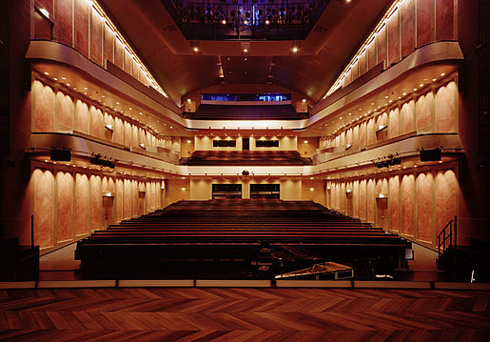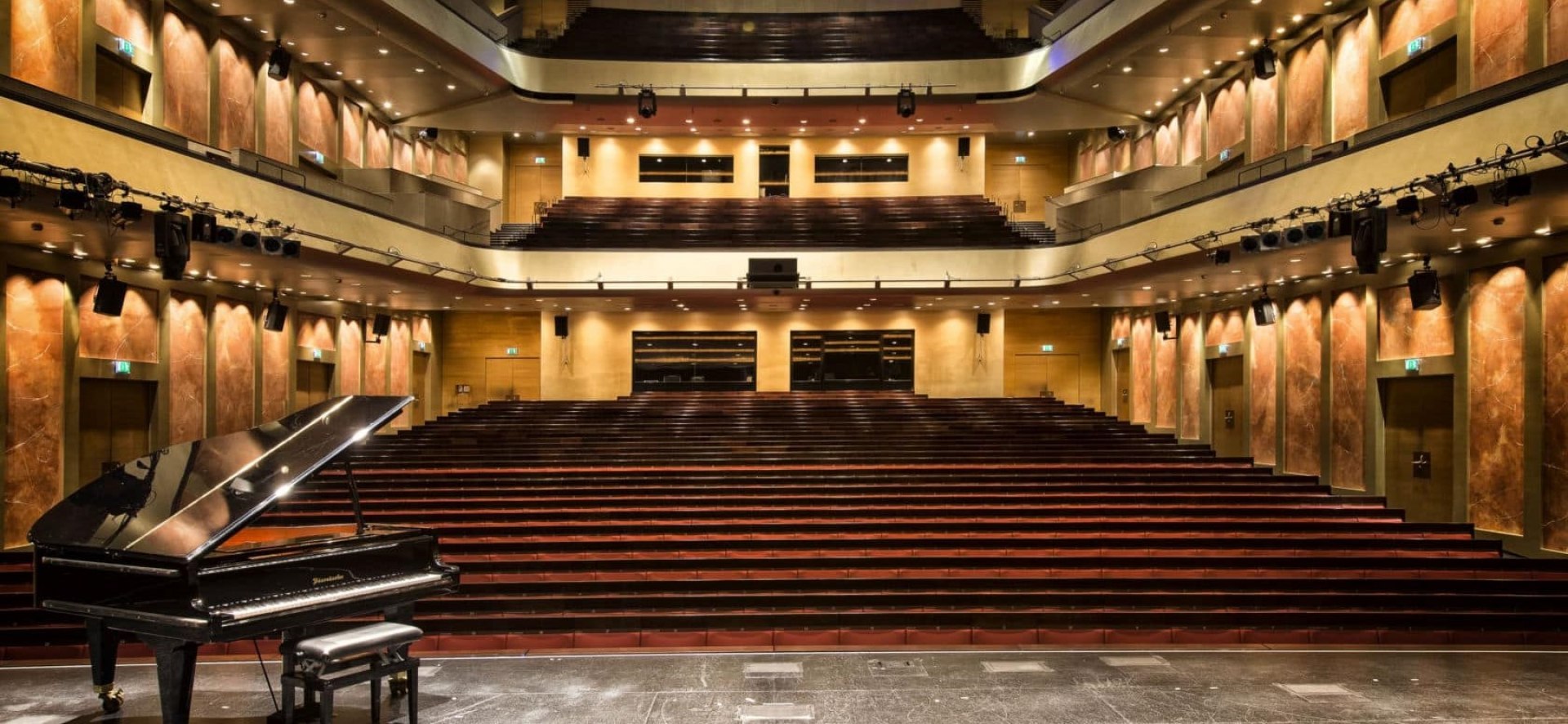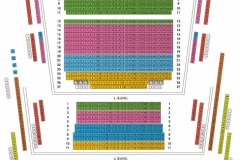Julius Caesar in Egypt
Mo | Tu | We | Th | Fr | Sa | Su |
George Frideric Handel (1685 - 1759)
Julius Caesar in Egypt
Opera seria in three acts HWV 17 (1724)
Libretto by Nicola Francesco Haym
after Giacomo Francesco Bussani’s libretto
for Antonio Sartorio’s opera Giulio Cesare in Egitto
New production
Synopsis
Place: Egypt
Time: 48–47 B.C.
As with most of his other operas, Handel made several revisions to the score of Giulio Cesare for revivals, adding new arias and cutting others. The listing of arias in this synopsis applies to the original 1724 version.
Abridged plot
Cesare, in pursuit of his enemy Pompeo, follows him to Egypt. Pompeo's wife Cornelia pleads with Cesare to spare her husband. He is about to grant her plea, when the Egyptians led by their boy king Tolomeo bring him the head of Pompeo. Cornelia and Pompeo's son Sesto vows to avenge his death. Tolomeo's sister Cleopatra desires to depose her brother in order to become the sole ruler of Egypt. She joins Cornelia and Sesto in their plans for vengeance and entreats Cesare to aid her. Following her overtures, Cesare falls in love with Cleopatra. Her brother attempts to assassinate Cesare, but he escapes. It is reported to Cleopatra that Cesare has drowned while in flight. She is taken captive by her brother. Cesare, who has escaped drowning, enters to free his beloved. Tolomeo is slain by Sesto, because he forced himself upon Cornelia against her will. Cesare makes Cleopatra Queen of Egypt and returns to Rome.
Act 1
After the overture, the entire cast, except Giulio Cesare, gathers on stage for the opening chorus, a victory song which compares Cesare to Hercules. (Chorus: Viva, viva il nostro Alcide). Giulio Cesare and his victorious troops arrive on the banks of the River Nile after defeating Pompeo's forces. (Aria: Presti omai l'Egizia terra). Pompeo's second wife, Cornelia, begs for mercy for her husband's life. Cesare agrees, but on the condition that Pompeo must see him in person. Achilla, the leader of the Egyptian army, presents Cesare with a casket containing Pompeo's head. It is a token of support from Tolomeo, the co-ruler of Egypt (together with Cleopatra, his sister). Cornelia faints, and Cesare is furious about Tolomeo's cruelty. (Aria: Empio, dirò, tu sei). Cesare's assistant, Curio, offers to avenge Cornelia, hoping that she will fall for him and marry him. Cornelia rejects the offer in grief, saying that another death would not relieve her pain. (Aria: Priva, son d'ogni conforto). Sesto, son of Cornelia and Pompeo, swears to take revenge for his father's death. (Aria: Svegliatevi nel core). Cleopatra decides to use her charm to seduce Cesare. (Aria: Non disperar, chi sà?) Achilla brings the news to Tolomeo that Cesare was furious over the murder of Pompeo. Tolomeo swears to kill Cesare to protect his rule of the kingdom. (Aria: L'empio, sleale, indegno). Cleopatra (in disguise) goes to meet Cesare in his camp hoping that he will support her as the queen of Egypt. Cesare is amazed by her beauty. (Aria: Non è si vago e bello). Nireno notes that the seduction was successful. (Aria: Tutto può donna vezzosa). Meanwhile, Cornelia continues to mourn the loss of her husband. (Arioso: Nel tuo seno, amico sasso). Cornelia prepares to kill Tolomeo to avenge Pompeo's death, but is stopped by Sesto, who promises to do it instead. Cesare, Cornelia and Sesto go to the Egyptian palace to meet Tolomeo. (Aria: Cara speme, questo core). Cleopatra now believes that as she has turned Cesare, Cornelia and Sesto against Tolomeo successfully, the scales are tipped in her favour. (Aria: Tu la mia stella sei). Cesare meets Tolomeo, who offers him a room in the royal apartments, though Cesare tells Curio that he expects Tolomeo to betray him. (Aria: Va tacito e nascosto). Tolomeo is fascinated by Cornelia's beauty but has promised Achilla that he could have her. (Aria: Tu sei il cor di questo core). Sesto attempts to challenge Tolomeo, but is unsuccessful. When Cornelia rejects Achilla, he orders the soldiers to arrest Sesto. (Duet: Son nata a lagrimar).
Act 2
In Cleopatra's palace, while in disguise as "Lidia", she uses her charms to seduce Cesare. (Aria: V'adoro, pupille). She sings praises of Cupid's darts and Cesare is delighted. Cesare is smitten with Cleopatra, and Nireno tells Cesare that "Lidia" is waiting for him. (Aria: Se in fiorito ameno prato). In Tolomeo's palace, Cornelia laments her fate. (Arioso: Deh piangete, oh mesti lumi). Achilla pleads with Cornelia to accept him, but she rejects him. (Aria: Se a me non sei crudele) When he leaves, Tolomeo also tries to win her, but is also rejected. (Aria: Sì spietata, il tuo rigore). Thinking that there is no hope, Cornelia tries to take her own life, but is stopped by Sesto, who is escorted by Nireno. Nireno reveals the bad news that Tolomeo has given orders for Cornelia to be sent to his harem. However, Nireno also comes up with a plan to sneak Sesto into the harem together with Cornelia, so Sesto can kill Tolomeo when he is alone and unarmed. (Aria: Cessa omai di sospirare). Sesto enters the garden of the palace, wishing to fight Tolomeo for killing his father. (Aria: L'angue offeso mai riposa). Meanwhile, Cleopatra waits for Cesare to arrive in her palace. (Aria: Venere bella). Still smitten with her, Cesare arrives in Cleopatra's palace. However, Curio suddenly bursts in and warns Cesare that he has been betrayed, and enemies are approaching Cesare's chambers and chanting "Death to Cesare". Cleopatra reveals her identity and after hearing the enemies heading for them, asks Cesare to flee, but he decides to fight. (Aria: Al lampo dell'armi). (Chorus: Morà, Cesare morà). Cleopatra, having fallen in love with Cesare, begs the gods to bless him. (Aria: Se pietà di me non senti). In Tolomeo's palace, Tolomeo prepares to enter his harem. (Arioso: Belle dee di questo core). As Tolomeo tries to seduce Cornelia, Sesto rushes in to kill Tolomeo, but is stopped by Achilla. Achilla announces that Cesare (in the attempt to run from soldiers) has jumped from the palace window and died. Achilla asks again for Cornelia's hand in marriage but is turned down by Tolomeo. Furious, Achilla leaves. Sesto feels devastated and attempts to kill himself but is prevented from doing so by his mother; he repeats his vow to kill Tolomeo. (Aria: L'aure che spira).
Act 3
Furious at Tolomeo for being ungrateful to him despite his loyalty, Achilla plans to defect to Cleopatra's side (Aria: Dal fulgor di questa spada), but Tolomeo stabs him before he does. As battle rings out between Tolomeo's and Cleopatra's armies, Tolomeo celebrates his apparent victory against Cleopatra (Aria: Domerò la tua fierezza). Cleopatra laments losing both the battle and Cesare (Aria: Piangerò la sorte mia). However, Cesare is not dead: he survived his leap and is roaming the desert in search of his troops (Aria: Aure, deh, per pietà). While looking for Tolomeo, Sesto finds the wounded, nearly dead Achilla, who hands Sesto a seal authorizing him to command his armies. Cesare appears and demands the seal, promising that he will either save both Cornelia and Cleopatra or die (Aria: Quel torrente, che cade dal monte). With Cesare alive and Achilla dead, Sesto's spirits lift, and he vows to fight on (Aria: La giustizia ha già sull'arco). Cesare continues on to Cleopatra's camp, where a lamenting Cleopatra is overjoyed to see him. (Aria: Da tempeste il legno infranto).
In the palace, Sesto finds Tolomeo trying to rape Cornelia and kills him. Having successfully avenged Pompeo, Cornelia and Sesto celebrate Tolomeo's death. (Aria: Non ha più che temere). The victorious Cesare and Cleopatra enter Alexandria, and Cesare proclaims Cleopatra to be queen of Egypt and promises his support to her and her country. They declare their love for each other (Duet: Caro! Bella! Più amabile beltà). Cesare then proclaims Egypt's liberation from tyranny, and wishes for the glory of Rome to spread far and wide. For the final chorus, the entire cast (including the dead Achilla and Tolomeo) gathers on stage to celebrate the power of love and the triumph of good over evil (Chorus: Ritorni omai nel nostro core).
Program and cast
Emmanuelle Haïm - Musical Direction and Harpsichord
Dmitri Tcherniakov - Direction and Set Design
Elena Zaytseva - Costumes
Gleb Filshtinsky - Lighting
Tatiana Werestchagina - Dramaturgy
Christophe Dumaux - Giulio Cesare
Olga Kulchynska - Cleopatra
Lucile Richardot - Cornelia
Federico Fiorio - Sesto
Yuriy Mynenko - Tolomeo
Andrey Zhilikhovsky - Achilla
Jake Ingbar - Nireno
Bachchor Salzburg
Michael Schneider - Choral Preparation
Le Concert d’Astrée
House for Mozart

When it became clear that the ambitious plans to build a festival stage in Hellbrunn could not be realised, the idea was born of transforming parts of the court stables into a theatre. After a building period lasting only four months a provisional festival hall was built on the grounds of the large winter riding school in 1925 which was opened with Das Salzburger Grosse Welttheater. Only one year later, in 1926, the architect Clemens Holzmeister supervised a first phase of re-building of the inadequate provisional festival hall. Adaptations were again made in 1927 so that operas could be performed: Beethoven’s Fidelio was the first opera to be performed here.
The building was known as the Kleines Festspielhaus, and underwent several more reconstruction phases: in 1937 the auditorium was turned around by 180° which meant that it was necessary to build on a fly tower for the backstage area. In order to make this possible, the then governor of Salzburg, Franz Rehrl, allowed his birthplace in the Toscanini courtyard to be pulled down. Benno von Arent redesigned the festival hall in 1939 and replaced the wooden panelling with stucco work ornamented in gold. The unsatisfactory sight lines and acoustic problems made a further conversion necessary in the years 1962/63. The Salzburg architects Hans Hofmann and Erich Engels gave the hall the form it had until 2004.
For many years the Salzburg Festival had followed plans to create a “House for Mozart” which would in every respect be suitable for the performance of the composer’s stage works, with excellent acoustics and the best possible sight lines from all seats. The auditorium had to be both intimate but also have sufficient seating capacity. The task that seemed like squaring the circle was achieved by the team of architects Holzbauer and Valentiny: what was previously known as the Kleines Festspielhaus was transformed in three building phases from September 2003 into a Haus für Mozart (House for Mozart). The auditorium of the Kleines Festspielhaus was widened, shortened and lowered. Two new audience circles were created which extend on both sides of the hall as far as the stage. This creates the effect that the stage is framed on three sides by people in festive mood rather than by bare walls.
In comparison with the previous situation in the Kleines Festspielhaus the foyers have undergone major changes. Tall windows extending over two floors offer views from the main foyer to the city, and in the evenings the lighted interior of the theatre creates an inviting impression. The main foyer is dominated by a 17-metre high gilded lamella wall; through the openings a profile of Mozart’s head made of Swarovski crystal can be seen. The terrace above the hall construction had never been accessible to the public since its construction in 1924; now, with the new design, it has become part of the interval foyer. The arcade below is made predominantly of glass and means that the auditorium opens out on two sides instead of only one, as was the previous situation. Thus people can step out directly from the festival hall into the magnificent urban surroundings.
The festival lounge on the roof, the SalzburgKulisse, has become a great attraction (made possible by Gerhard Andlinger). The name in itself already suggests the splendid view offered from there to the old town centre of Salzburg. This lounge is furnished with pear-wood panelling; the tapestries in the alcoves are by Anton Kolig, a contemporary of Anton Faistauer.
The Faistauer Foyer has become a jewel of the new house (made possible by Herbert Batliner): the famous frescoes in this hall, which were created by the Salzburg painter Anton Faistauer in 1926, were removed after the Nazis marched into Austria and some of them were deliberately destroyed. Not until 1956 was it possible to re-mount them. For the opening of the Haus für Mozart they were thoroughly restored, and architecturally the foyer has been returned to its original historic design.
As regards the exterior façade the proportions of the Holzmeister ensemble from the years 1924/37 have been retained. The visual impression of the façade is characterised by the prestigious doors opening out onto the terrace which were designed by the sculptor Josef Zenzmaier: he created three bronze reliefs which are mounted above the portals and depict scenes from Mozart’s Le nozze di Figaro, Don Giovanni and Die Zauberflöte. The stone masks by Jakob Adlhart are now clearly visible above the entrance to the house: this is under the new extensive concrete roof decorated in gold leaf. Throughout the entire building rough concrete surfaces are contrasted with fine gold leaf, thus creating aesthetic tension.
From the backstage area a huge iron door opens onto the Toscanini courtyard. The six concrete reliefs mounted to the left and right Genies holding Masks were removed in 1938 but reconstructed again in 1979 by their creator Jakob Adlhart. Above them is an organ which was played for performances of Jedermann when they had to be transferred from the Domplatz to the Festspielhaus due to bad weather.
For the celebrations for Mozart’s 250th birthday in Mozart Year 2006 the Haus für Mozart was opened with the premiere of Le nozze di Figaro (conductor: Nikolaus Harnoncourt, stage director: Claus Guth).

 EN
EN DE
DE IT
IT FR
FR ES
ES RU
RU JP
JP RO
RO
 Seating plan
Seating plan